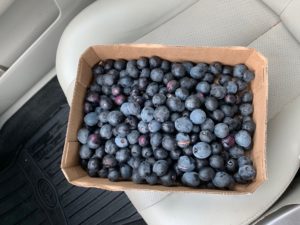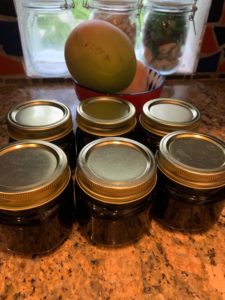You have seen them, and perhaps wondered what they were. Purple oblong fruits, tucked away in hedges in mundane places – at the supermarket, drug store, church, school – wherever this popular hedge plant has made its home. The Cocoplum (Chrysobalanus icaco) has become a favorite landscape hedge of South Florida over the last 30 years. Its attractive red and green foliage creates a dense hedge that is drought and salt resistant, but a visit from Jack Frost would not be welcome. A true South Florida native, Cocoplums are found throughout the Caribbean, even as far away as West Africa.
I knew they were edible from a class I took in high school on all the native plants that can be eaten, and I had read accounts of the pioneers using them to make jelly. I even tried a few fruits over the years, but found them rather bland and tasteless. The purple skin of the red tip variety hides a white pulp and large pit. I had a Bahamian cookbook my mother gave me from a trip to Abaco, and in it were some recipes for Cocoplum jam. I had dabbled in jam making through the years, but had not cooked jam in many years. A recent trip to a central Florida blueberry farm left me with several pounds of fresh blueberries, so I got to cooking. I had forgotten how delicious homemade jam was.
A friend asked what Florida native fruits there were to make into jam. I thought of the cocoplum, so I began to search them out. I saw a few in some hedges, and many of the white “Coastal” variety growing in a park, but harvesting isn’t allowed in public parks. A chance trip down a side street off of Parker Avenue in West Palm Beach brought me to an untrimmed shrub loaded with the purple fruits, some the size of ping pong balls. I collected a good many in a paint tray I had just bought, as I didn’t have anything else in the car.
I looked up some recipes and started them simmering on the stove – I washed them, removed any stems, and put them in the pot. As they began to boil, I must say the smell was not too pleasant – kind of reminiscent of old socks. But I didn’t want to give up just yet. Once the fruit had boiled, I squeezed the juice from them, and measured it out. Once I began to heat up the juice, a delightful aroma emerged from the simmering juice. I added a box of powdered pectin, got that to a boil, then added an equal amount of sugar to juice. It took a while to get back to a boil, and then I boiled it about 3 minutes. I ladled the beautiful burgundy colored hot liquid into prepared jelly jars, sealed the lids, then processed for 10 minutes in boiling water. It took about 24 hours for the jelly to fully “set” – then came the telling moment – how was it? Delicious…kind of a cross between blackberry and grape, maybe with a bit of boysenberry thrown in.
I imagined all sorts of possibilities beyond jelly – syrup for pancakes or drinks, or to drizzle over a piece of key lime pie; perhaps a basis for a tropical barbecue sauce. The cocoplum is also proving to be a medical wonder. It is being studied as a possible treatment for colon cancer, and also for use with chemotherapy to stop DNA damage. It is very high in resveratrol, that magic blue substance found in blueberries and red wine. Some people also “pickle” the cocoplums and claim they taste like olives (I have not tried that), or they dry them in the sun or in the oven. It also has a “bonus” treat – inside the pit is a “nut” or seed that is very high in oil and tastes sort of like a boiled peanut. The oil was used throughout the Caribbean to make candles or in cooking before cheaper substitutes took over.
So next time you see bushes full of these magical fruits, why not try some? Do make sure that you are permitted to pick, and that the bushes haven’t been sprayed with insecticide (look for spiders or ants).
Cocoplum Jelly or Jam
80-100 Fresh Purple Cocoplums (the white ones can be used but will not result in the delightful purple color)
1 box powdered Sure Jell Pectin for low sugar recipes (pink box)
Sugar (see below)
1/4 cup lemon juice (bottled)
Wash the Cocoplums well, removing any stems. Place in a large pot and cover with water. Place pot on medium heat till they simmer, and simmer for 1 hour, occasionally crushing the fruit with a potato masher. If you want to make a clear jelly, strain the hot fruits through a colander lined with cheesecloth and let the juice drip out into another pot or bowl (or use a jelly bag). If you want a heartier jam, squeeze the fruits through the colander without cheesecloth so more fruit bits end up in the juice.
Measure your resulting juice. Then measure an equal amount of sugar, or up to 1/2 cup less if making jam (i.e., 4 cups of juice would mean 4 cups of sugar for jelly, 3 1/2 cups for jam) and set aside. Prepare your jars for canning (see this link for details – https://www.thespruceeats.com/preparing-jars-for-canning-3052438). Return the juice to a clean pot, mix in the box of pectin and lemon juice, and stir according to pectin box instructions. The mixture is ready for the sugar when it is boiling and cannot be stirred down. Add the sugar all at once (careful of splashing) and stir constantly as the mixture returns to a boil. Once it has reached boiling and cannot be stirred down, boil for three minutes. I find this does not foam up at all, probably due to the oil from the kernels inside the pit. Remove a hot jar from the water bath and fill the jar using a wide mouth funnel (you really need a funnel and a pair of jar tongs – less than $5 at WalMart). Fill each jar within 1/4 of the top, clean the rim with a wet paper towel, and place a sterilized lid on the jar and tighten the band. Once all the jars are filled, return them to the hot water pot where you sterilized the jars and process them 10 minutes. Carefully remove the jars with the jar tongs and place on a counter to cool 24 hours. You will hear each jar “pop” as the vacuum seal forms. Check after 24 hours and make sure all the seals are depressed down. If you find one that is not properly sealed, store it in the refrigerator. Otherwise the jars can be stored up to one year in a cool dark place. But once you taste it, the jars won’t last that long.
Variations:
Spiced Cocoplum Jam – Add 1 teaspoon of cinnamon and 1/4 teaspoon of cloves to the pressed juice.
Cocoplum Syrup – Make as above for jelly, but omit pectin, and store in the refrigerator.









I have a cocoplum hedge around my backyard, and it has a lot of fruits. I am going to try picking them and making this jam. Also drying them.
Worked out really well
Didn’t realize what they were in my front garden till this year
I’ve picked lots more frozen them whole for making jam later
Is that ok?
Valerie Fl
I made wine from our hedge in our back yard of our winter home. It’s in a carboy and will bottle it soon. The color is beautiful and hope I can find the recipe I developed to make it again.